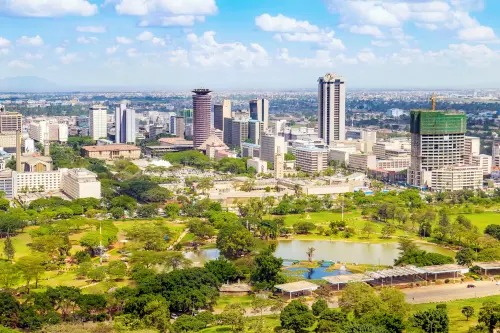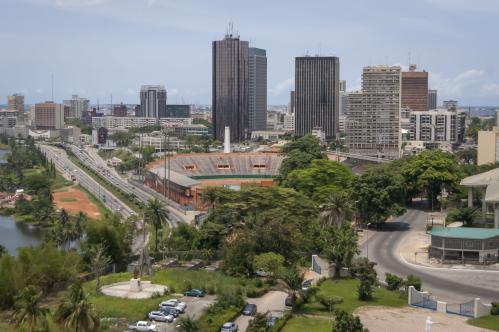Below is a viewpoint from the Foresight Africa 2023 report, which explores top priorities for the region in the coming year. Read the full chapter on Africa’s cities.
 At about 4.4 percent, Africa has the fastest urbanization rate globally. Already, the region has reached 40 percent urbanization and by 2050, the number of urban residents will have doubled. Moreover, about 60 percent of Africa’s urban population today lives in informal low-income neighborhoods.
At about 4.4 percent, Africa has the fastest urbanization rate globally. Already, the region has reached 40 percent urbanization and by 2050, the number of urban residents will have doubled. Moreover, about 60 percent of Africa’s urban population today lives in informal low-income neighborhoods.
In most countries, urbanization leads to substantial productivity gains supported by scale, density, and agglomeration. Better connected people and firms lead to savings in transport and logistics, technological and information spillovers, and more efficient labor markets. However, Africa’s urbanization has not realized the full potential and benefits of such agglomeration. The economic transformation and benefits of urbanization, observed in other regions, are yet to be achieved in sub-Saharan Africa.
To understand the barriers, and unlock the economic opportunities of urbanization, the Africa Growth Initiative (AGI) at the Brookings Institution developed an “Urban Economic Growth Framework for African cities.” The framework focuses on the three primary constraints limiting a city’s ability to benefit from agglomeration and generate productive jobs: Accessibility, the business environment, and public sector governance. The framework provides specific indicators and ways to identify these three critical constraints, with a view to inform and guide policymakers on specific actions and appropriate policies.
As a start, the AGI framework was applied to the city of Nairobi (Kenya’s capital), to analyze Nairobi’s key challenges and possible solutions for growth and employment.
Unemployment and underemployment in Nairobi are a top concern, especially as youth makeup 48 percent of the total unemployed workforce (15 to 64 years). While the labor force in Kenya has been growing at an average annual rate of about 3 percent, Nairobi needs to generate many more (and better) jobs to offer improved livelihood opportunities to its large youth demographic. At the national level, Kenya has registered good progress in creating jobs, especially in the digital and gig economy. The report recommends two areas of focus. First, in coordination with the national government, Nairobi City County needs to support the gradual formalization of the large number of informal jobs and enterprises by easing business registration and motivating registration through targeted support programs. Second, better education and skills in targeted economic sectors are required to enhance productivity and earnings. Nairobi city should ensure that tertiary institutions provide training and skills consistent with emerging technologies.
[Nairobi] city has enormous potential to achieve the benefits of urban agglomeration and create productive jobs by paying particular attention to its challenges in accessibility and infrastructure, business environment, as well as public sector governance and finance.
Furthermore, enterprise data in Nairobi shows that businesses are likely to transition from micro- to medium-, and to large enterprises as the owners’ levels of education attainment rises.
Accessibility within the city: Accessibility is vital for connecting workers to firms and firms to markets. Despite the excellent progress made on infrastructure development, there is a high concentration of unpaved roads in Nairobi’s high-density informal settlements.
Consequently, as shown in the report, most jobs are not accessible within one hour of public transport commute i.e., commuting time by bus, matatu (shared taxi), or foot. The city also has a mismatch in zoning and land use. Nairobi therefore needs a new approach to urban planning that considers population growth, infrastructure, housing, and land use. Equally important is updating the land appraisal system and creating more public spaces.
Business environment: Many businesses in the city face several challenges, including complex processes to access licenses and permits, insufficient finance, expensive land, rigid labor regulations, inefficiency in tax administration, and crime risk. For example, a business takes about 92 days to secure an electricity connection. A firm loses about KSh 2.3 million per year due to power outages on average. These are critical areas for Nairobi to enhance its business environment. Furthermore, it is essential to coordinate the implementation of business policy reforms between the national and county governments.
Public sector governance and finances: The devolution process in Kenya has given Nairobi City County a total of 14 constitutional functions. The city faces important challenges in terms of financing, despite the commendable increase in revenues and fiscal transfers from KSh 9.51 billion in FY 2013/14 to KSh 19.42 billion in FY 2020/21. Still, the city faces several financing shortfalls, from high levels of pending bills and fiscal deficits, to delays in receipt of equitable fiscal transfers. These challenges call for proper budget planning, improved budget execution, and higher levels of the city’s source revenue.
The application of the AGI Urban Economic Growth Framework to Nairobi City County shows that the city has enormous potential to achieve the benefits of urban agglomeration and create productive jobs by paying particular attention to its challenges in accessibility and infrastructure, business environment, as well as public sector governance and finance.








Commentary
Urban economic development in Africa: A case study of Nairobi city
February 17, 2023